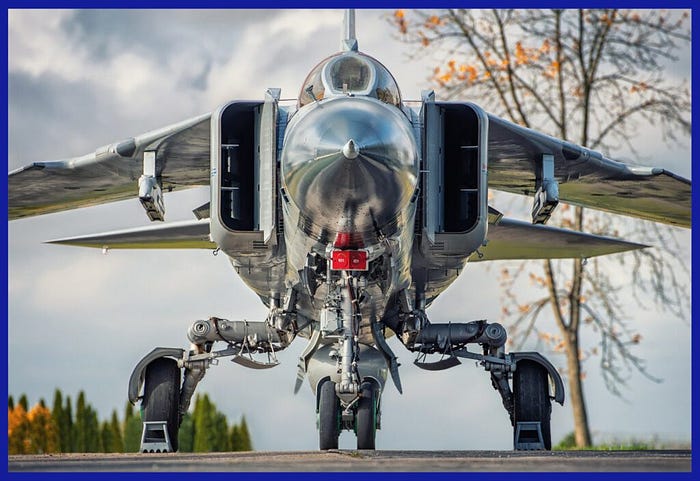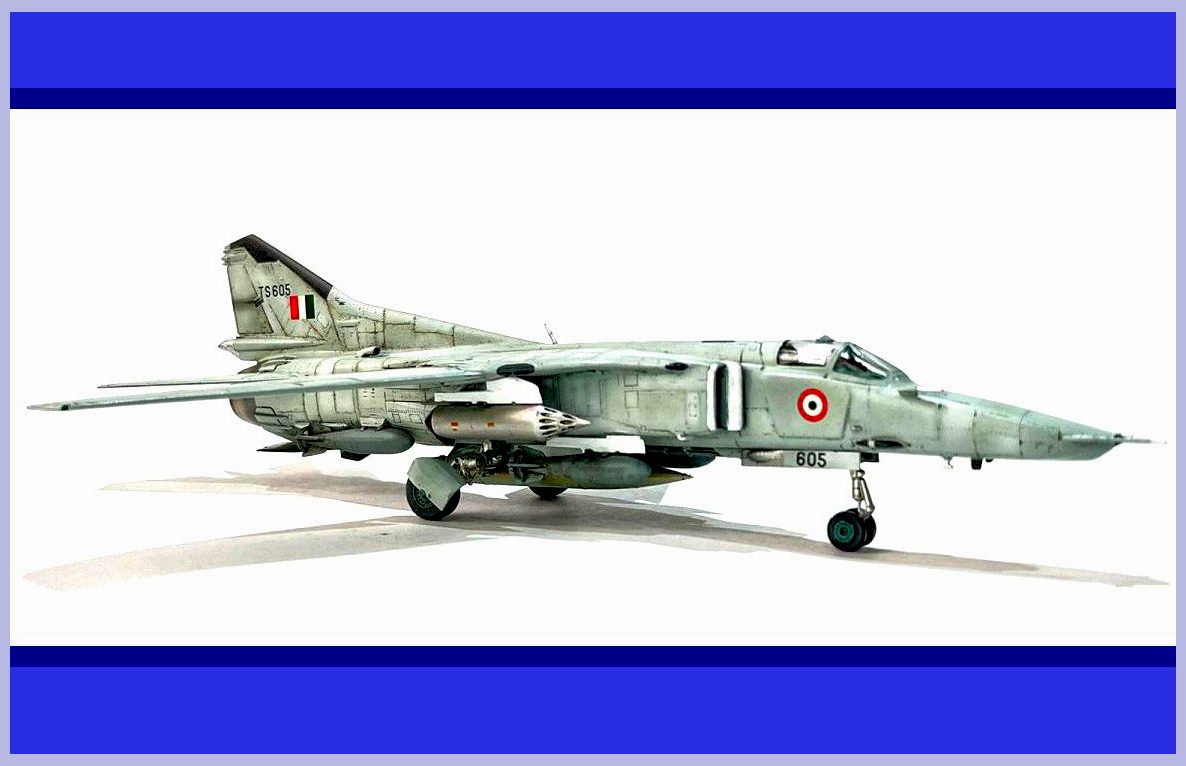With a legacy spanning decades, let us delve into the remarkable achievements of the MiG-23 and MiG-27, paying homage to their groundbreaking swing-wing technology and the prolific production witnessed during the Soviet Era. Let’s Recap The Details Of The MiG-23 And MiG-27 In 2023, with due respect to the swing-wing aircraft technology and massive production during the Soviet Era. The MiG-23 is a Soviet-era fighter aircraft that entered service in the 1970s. It was designed as a multi-role fighter, capable of both air-to-air and air-to-ground missions.
The MiG-23 has a maximum speed of Mach 2.35 and a service ceiling of 59,000 feet. It retired from Russia in 1997. On the other side, the MiG-27 was a ground attack variant of the MiG-23. It entered service in the 1980s and was designed specifically for ground-attack missions, with almost 98% commonality in design.
The Mig-27 boasts a maximum speed of Mach 1.7 and a service ceiling of 40,000 feet, making it a formidable ground attack aircraft. Although it was retired from active service in Russia in 1993, it still remains operational in a few other countries. These fighters were armed with lethal combinations of 23mm and 30mm cannons, along with the ability to carry a wide range of air-to-ground missiles and bombs. With their impressive speed, altitude capabilities, and versatile weaponry, the MiG-23 and MiG-27 were among the most powerful aircraft of their time.

Both the MiG-23 ( NATO code name — Flogger ) and MiG-27 ( NATO code name — Flogger-D ) were significant aircraft of their time, with the MiG-23 being one of the Soviet Union’s most widely exported fighters ( over 5,000 were built ) and the MiG-27 being an effective ground-attack aircraft. However, both aircraft are now considered outdated and have been largely replaced by newer aircraft designs.
Analyzing The Development Of The MiG-23 and MiG-27
The development of the MiG-23 and MiG-27 was a complex and challenging process, involving many different design iterations, technical challenges, and political considerations.
The MiG-23 was developed in the 1960s as a replacement for the MiG-21. The development process was heavily influenced by the Soviet Union’s rivalry with the United States, and the need to develop a fighter that could match the capabilities of the American F-4 Phantom II.
The design of the MiG-23 underwent several iterations, with early prototypes featuring a variable-sweep wing and a single engine. However, these early designs encountered significant technical challenges, including engine problems and issues with the variable-sweep wing. The final design of the MiG-23 featured a Tumansky R-29B-300 turbojet engine, which had a maximum thrust of 12,500 kg ( 27,557 lb ), as well as a more reliable variable-sweep wing configuration, which gave the aircraft its distinctive wedge-shaped fuselage.
The MiG-23 entered service with the Soviet Air Force in the mid-1970s and was exported to many countries around the world. However, the aircraft had several drawbacks, including high maintenance costs and limited range, which made it less effective in some situations. The MiG-27 was developed as a specialized ground-attack variant of the MiG-23. The development process was driven by the Soviet Union’s experience in the Afghan War, where the need for a dedicated ground-attack aircraft became apparent.

The design of the MiG-27 was based on the MiG-23 but with significant modifications to the wing configuration, engine, and armament. The aircraft was optimized for low-altitude flight and had a more powerful armament than the MiG-23, including a 30mm cannon and the ability to carry a wide range of air-to-ground missiles and bombs.
The MiG-27 entered service with the Soviet Air Force in the early 1980s and was also exported to several countries. However, the aircraft was relatively short-lived, with production ending in the late 1980s due to the collapse of the Soviet Union. Overall, the development of the MiG-23 and MiG-27 was influenced by many different factors, including technical considerations, geopolitical considerations, and changing strategic priorities.
Analyzing The Design Of The MiG-23 and MiG-27
Compared to the MiG-23, the MiG-27 had a more specialized design focused on ground-attack missions. Here are some of the key differences in the design of the MiG-23 and MiG-27:
- Wing Configuration: The MiG-27, in contrast to the MiG-23 with its variable-sweep wing, adopted a fixed-wing configuration optimized for low-altitude flight. This specific wing design offered enhanced lift and manoeuvrability at lower speeds, making it particularly suitable for ground-attack missions. As the MiG-27 was primarily designed for low-altitude operations, the variable intake ramps and exhaust nozzles found on the MiG-23 were replaced with a simpler fixed configuration, resulting in reduced weight and maintenance demands.
- The aircraft was also equipped with larger, heavy-duty landing gear to support operations from airfields with poorer conditions. To meet the MiG-27’s strike and low-level attack requirements, provisions were made for mounting missiles and precision-guided munitions. Furthermore, the aircraft retained a nuclear capability in alignment with other Soviet combat aircraft through the incorporation of specialized navigation systems.
- Engine: The MiG-27 was also powered by a different engine than the MiG-23. It was equipped with a single Tumansky R-29B-300 turbojet engine, which gave it a top speed of Mach 1.7. The single-engine configuration reduced maintenance costs but made the aircraft more vulnerable to engine failures. However, later models of the MiG-23, such as the MiG-23ML and MiG-23MLD, were powered by the Tumansky R-29B-300 turbojet engine, which had a maximum thrust of 12,500 kg ( 27,557 lb ). These engines were also equipped with afterburners, which allowed the aircraft to reach supersonic speeds of Mach-2.3
- Armament: The MiG-27 boasted a more potent armament compared to the MiG-23, featuring a 30mm cannon and the capability to carry a diverse array of air-to-ground missiles and bombs. Its design was optimized for ground target attacks, and a specialized targeting system was incorporated for this specific purpose. Despite this focus, the MiG-23 was ingeniously designed to remain agile and lightweight, allowing it to excel in dogfighting with enemy fighters, making it an exceptionally lethal air-to-air combat machine.
- In fact, the MiG-23 was primarily intended for air-to-air combat and was equipped with the necessary armaments, including air-to-air missiles, to effectively engage in such aerial confrontations. Furthermore, the MiG-23 retained the versatility of carrying air-to-ground weapons, providing an added edge during missions. Its remarkable manoeuvrability, combined with its high speed, rendered it a formidable opponent in aerial combat during that era.
- Avionics: While the MiG-27 had some advanced avionics for its time, including a radar system and electronic countermeasures, it was generally less sophisticated than the MiG-23 in terms of its electronics and navigational equipment.

Overall, the MiG-23 and MiG-27 had different design priorities, with the MiG-23 being a more versatile multirole fighter and the MiG-27 being a specialized ground-attack aircraft. The MiG-23 had a more advanced wing configuration and engine system, while the MiG-27 had a more powerful armament and was optimized for low-altitude flight. Both aircraft were significant designs for their time but have been largely replaced by newer aircraft. For example, the MiG-29 has replaced the MiG-23, and the Su-25 has replaced the MiG-27 in the modern Russian air force.
Countries That Successfully Operated The MiG-23 and MiG-27
The MiG-23 and MiG-27 were widely exported during the Cold War era and were operated by several countries around the world. While it is difficult to determine an exact number, It is estimated that the MiG-23 was operated by around 30 countries, including China and the USA.
( Chinese story: In a bold move, China obtained MiG-23s from Egypt for reverse engineering, hoping to incorporate its revolutionary variable wing design into their Nanchang Q-6 aircraft. Alas, despite their best efforts, the ambitious program was unable to proceed, and the Q-6 remained a dream. Despite this setback, some features from the MiG-23 were incorporated into the J-8II aircraft, but unfortunately, it failed to achieve the same level of fame and success. Today, China proudly displays the MiG-23 in several air museums as a testament to their ambitious pursuits )
( American usage: Acquired from Egypt, the MiG-23s arrived in the US and were strategically stationed at Nellis Air Force Base. The U.S. Air Force obtained only a limited number of these war machines, officially designated YF-113. They were primarily used for testing and evaluation purposes and also for the training of fighter pilots in an aggressor role. From 1977 through 1988, the program was code-named “Constant Peg,” where the MiG-23s served as formidable opponents for US fighter pilots to improve their combat skills and tactics against potential enemy fighters )

The MiG-27 was operated by around 8 countries including India!
Indian Usage: MiG-23 – The Indian Air Force officially phased out the MiG-23BN ground attack aircraft on March 6, 2009, marking the end of an era for this formidable platform. Simultaneously, the MiG-23MF air defence interceptor bid farewell to the skies in 2007, closing a significant chapter in the history of Indian aviation. According to the latest information from the authoritative source “World Air Forces 2020,” a modest fleet of 14 MiG-23UB trainers is still in active service, contributing to ongoing training and general operational needs.
MiG-27 – The story of the MiG-27 in India is one of indigenous production and gradual retirement. HAL in India proudly licensed and built a total of 165 MiG-27Ms, showcasing the nation’s capabilities in aerospace manufacturing. The initial phase of MiG-27 retirements occurred in December 2017, marking the end of an era for the first batch of these formidable ground-attack aircraft. Subsequently, the final batch bid adieu to active service on December 27, 2019, concluding a remarkable legacy of service in the Indian Air Force. These retirements reflect the ongoing modernization efforts and the transition to more advanced and contemporary aircraft in the Indian Air Force’s fleet.
However, it’s important to note that not all countries that operated these aircraft had large fleets, and some may have only operated them for a short period of time. Additionally, some of these countries may no longer operate the MiG-23 or MiG-27, as these aircraft have largely been replaced by newer designs in modern air forces.

Technical Specifications Of The MiG-23 And MiG-27
MiG-23 Flogger Specifications
- Crew: 1
- Dimensions: Wingspan: 45 ft 10 in ( 13.97 m ); Length: 54 ft 9 in ( 16.70 m ); Height: 15 ft 10 in ( 4.82 m )
- Empty Weight: 11,908 kg ( 26,252 lb )
- Maximum Takeoff Weight: 20,300 kg ( 44,753 lb )
- Powerplant: 1 × Khatchaturov R-35–300 afterburning turbojet, 83.6 kN ( 18,800 lbs ) thrust with variable-geometry nozzles dry / 127.49 kN ( 28,660 lbs ) with afterburner
- Maximum Speed: Mach 2.35 ( 2,499 km/h, 1,553 mph ) at altitude
- Range: Combat radius: 540 km ( 335 miles ) on a lo-lo-lo attack mission with two Kh-29 ASM
- Service Ceiling: 18,300 m ( 60,000 ft )
- g limits: +8.5
- Rate Of Climb: 39,370 ft ( 12,000 m ) per minute
- Armament: One 23mm GSh-23L cannon and up to 4,000 kg ( 8,800 lb ) of weapons, including air-to-air missiles ( R-23, R-60, R-73 ), air-to-ground missiles ( Kh-23, Kh-29 ), Rockets and bombs in 6 hardpoints
- Avionics: Sapfir-23 radar, R-23 air-to-air missiles, and various navigation and communication equipment

MiG-27 Flogger D Specifications
- Crew: 1
- Dimensions: Wingspan: 45 ft 10 in ( 13.97 m ); Length: 56 ft 10 in ( 17.32 m ); Height: 16 ft 5 in ( 5 M )
- Empty Weight: 11,908 kg ( 26,253 lb )
- Maximum Takeoff Weight: 20,670 kg ( 45,570 lb )
- Powerplant: One Tumansky R-29B-300 afterburning turbojet engine, producing 78.5 kN ( 17,640 lbs ) of thrust / 112.8 kN ( 25,400 lbs ) with afterburner
- Maximum Speed: Mach 1.7 ( 1,900 km/h, 1,180 mph ) at altitude
- Range: 780 km ( 480 mi ) with drop tank
- Service Ceiling: 12,500 m ( 41,010 ft )
- Rate of Climb: 39,000 ft per minute
- Armament: One 30mm GSh-6–30 cannon and up to 4,000 kg ( 8,800 lb ) of weapons, including air-to-ground missiles( Kh-25, Kh-29, Kh-31P ), rockets, and bombs in total 7 hardpoints
- Avionics: Radar and electronic countermeasures.
It is essential to emphasize that these specifications may vary depending on the particular variant of the aircraft and the configuration of its weapons and avionics.
Furthermore, for aviation enthusiasts and those interested in military history, a thrilling book on the MiG-23 and MiG-27 fighter aircraft is available for purchase on Amazon. This book delves into the technical aspects of aircraft and provides fascinating insights into their design, development, and operational history. By using the provided link, you can get your hands on this captivating book and embark on an exhilarating journey through the world of the MiG-23 and MiG-27. Don’t miss out on the opportunity to add this must-have book to your collection.

In conclusion, the MiG-23 and MiG-27 were two iconic aircraft that played significant roles in military operations during the Cold War era. These aircraft were designed with advanced technologies and capabilities that allowed them to perform various missions, including air-to-air and air-to-ground combat, interception and reconnaissance as well.
Although these aircraft have largely been retired from active service in modern air forces, they will always be remembered for their contributions to military aviation and their place in the history of military technology. Their legacy serves as a reminder of the ever-evolving nature of military technology and the importance of continual innovation and improvement.
Important Announcement for Our Valued Readers!
After an article is published, it is possible that updates or changes may have occurred beyond the time of publication. Therefore, it is important to be aware that certain information in the article might be outdated. To ensure the most accurate analysis, it is highly recommended to verify the content with the latest sources available.
However, we are dedicated to delivering outstanding articles on military products and global updates. Maintaining quality and smooth operation requires resources. Your support sustains our efforts in providing insightful content. By purchasing high-quality products through our affiliated links, you help us keep our platform alive and acquire top-notch items. Your unwavering support is invaluable and inspires us to strive further.
We welcome your suggestions and requests for more information, as we value feedback from our readers. If there’s specific defence material or equipment not covered on our site, please share your request in the comments. We’ll strive to research and provide the required information. We sincerely thank you for your unwavering interest in our website, and we eagerly anticipate hearing from you! Enjoy your reading experience!
